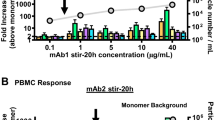Abstract
Tumor necrosis factor (TNF)-related, apoptosis-inducing ligand (Apo2L/TRAIL) has a unique homotrimeric structure, and its conformational stability is essential for its apoptotic activity. The conformational stability of a modified version of TRAIL(114–281) with two additional domains of histidine tag and isoleucine zipper [His-ILZ-TRAIL(114–281)] was evaluated in various pH environments according to three different biological or physicochemical considerations: cytotoxicity, antibody-binding affinity, and tertiary structure. The biological properties of His-ILZ-TRAIL(114–281) were the most stably maintained at pH 6.0. The physicochemical analyses (circular dichroism and fluorescence spectroscopy) demonstrate that its bioactivity loss by pH challenge was originated from its structural collapse as a homotrimer.






Similar content being viewed by others
References
Almasan A, Ashkenazi A (2003) Apo2L/TRAIL: apoptosis signaling, biology, and potential for cancer therapy. Cytokine Growth Factor Rev 14:337–348
Ashkenazi A, Pai RC, Fong S, Leung S, Lawrence DA, Marsters SA, Blackie C, Chang L, McMurtrey AE, Hebert A, DeForge L, Koumenis IL, Lewis D, Harris L, Bussiere J, Koeppen H, Shahrokh Z, Schwall RH (1999) Safety and antitumor activity of recombinant soluble Apo2 ligand. J Clin Invest 104:155–162
Bodmer J-L, Meier P, Tschopp J, Schneider P (2000) Cysteine 230 is essential for the structure and activity of the cytotoxic ligand TRAIL. J Biol Chem 275:20632–20637
Fan QL, Zou WY, Song L-H, Wei W (2005) Synergistic antitumor activity of TRAIL combined with chemotherapeutic agents in A549 cell lines in vitro and in vivo. Cancer Chemother Pharmacol 55:189–196
French LE, Tschopp J (1999) The TRAIL to selective tumor death. Nat Med 5(2):146–147
Hymowitz SG, Christinger HW, Fuh G, Ultsch M, O’Connell M, Kelley RF, Ashkenazi A, de Vos AM (1999) Triggering cell death: The crystal structure of Apo2L/TRAIL in a complex with death receptor 5. Mol Cell 4:563–571
Hymowitz SG, O’Connell MP, Ultsch M, Hurst A, Totpal K, Ashkenazi A, de Vos AM, Kelley RF (2000) A unique zinc-binding site revealed by a high-resolution X-ray structure of homotrimeric Apo2L/TRAIL. Biochemistry 39:633–640
Kelley SK, Harris LA, Xie D, Deforge L, Totpal K, Bussiere J, FOX JA (2001) Preclinical studies to predict the disposition of Apo2L/tumor necrosis factor-related apoptosis-inducing ligand in humans: Characterization of in vivo efficacy, pharmacokinetics, and safety. J Pharmacol Exp Ther 299:31–38
Kim M-H, Billiar TR, Seol D-W (2004) The secretable form of trimeric TRAIL, a potent inducer of apoptosis. Biochem Biophy Res Commun 321:930–935
Lawrence D, Shahrokh Z, Marsters S, Achilles K, Shih D, Mounho B, Hillan K, Totpal K, Deforge L, Schow P, Hooley J, Sherwood S, Pai R, Leung S, Khan L, Gliniak B, Bussiere J, Smith CA, Storm SS, Kelley S, Fox JA, Thomas D, Ashkenazi A (2001) Differential hepatocyte toxicity of recombinant Apo2L/TRAIL versions. Nat Med 7:383–385
Na DH, Youn YS, Lee SD, Son M-W, Kim W-B, DeLuca PP, Lee KC (2003) Monitoring of peptide acylation inside degrading PLGA microspheres by capillary electrophoresis and MALDI-TOF mass spectrometry. J Control Rel 92:291–299
Pitti RM, Marsters SA, Ruppert S, Donahue CJ, Moore A, Ashkenazi A (1996) Induction of apoptosis by Apo-2 ligand, a new member of the tumor necrosis factor cytokine family. J Biol Chem 271:12687–12690
Ruff MR, Gifford GE (1980) Purification and physico-chemical characterization of rabbit tumor necrosis factor. J Immunol 125:1671–1677
Saito R, Bringas JR, Panner A, Tamas M, Pieper RO, Berger MS, Bankiewicz KS (2004) Convection-enhanced delivery of tumor necrosis factor-related apoptosis-inducing ligand with systemic administration of temozolomide prolongs survival in an intracranial glioblastoma xenograft model. Cancer Res 64:6858–6862
Schneider P, Holler N, Bodmer J-L, Hahne M, Frei K, Fontana A, Tschopp J (1998) Conversion of membrane-bound Fas(CD95) ligand to its soluble form is associated with down regulation of its proapoptotic activity and loss of liver toxicity. J Exp Med 187:1205–1213
Smith RA, Baglioni C (1987) The active form of tumor necrosis factor is a trimer. J Biol Chem 262:6951–6954
Trabzuni D, Famulski KS, Ahmad M (2000) Functional analysis of tumour necrosis factor-α-related apoptosis-inducing ligand (TRAIL): cysteine-230 plays a critical role in the homotrimerization and biological activity of this novel tumoricidal cytokine. Biochem J 350:505–510
Walczak H, Miller RE, Ariail K, Gliniak B, Griffith TS, Kubin M, Chin W, Jones J, Woodward A, Le T, Smith C, Smolak P, Goodwn RG, Rauch CT, Schuh JCL, Lynch DH (1999) Tumoricidal activity of tumor necrosis factor-related apoptosis-inducing ligand in vivo. Nat Med 5:157–163
Youn YS, Na DH, Yoo SD, Song S-C, Lee KC (2005) Carbohydrate-specifically polyethylene glycol-modified ricin A-chain with improved therapeutic potential. Int J Biochem Cell Biol 37:525–1533
Xia XX, Shen YL, Wei DZ (2004) Purification and characterization of recombinant sTRAIL expressed in Escherichia coli. Acta Biochim Biophys Sin (Shanghai) 36:118–122
Acknowledgement
This work was supported by a grant from the Ministry of Science and Technology, Korea (M10414030001-05N1403-00140).
Author information
Authors and Affiliations
Corresponding author
Rights and permissions
About this article
Cite this article
Youn, Y.S., Shin, M.J., Chae, S.Y. et al. Biological and physicochemical evaluation of the conformational stability of tumor necrosis factor-related apoptosis-inducing ligand (TRAIL). Biotechnol Lett 29, 713–721 (2007). https://doi.org/10.1007/s10529-006-9300-7
Received:
Revised:
Accepted:
Published:
Issue Date:
DOI: https://doi.org/10.1007/s10529-006-9300-7




